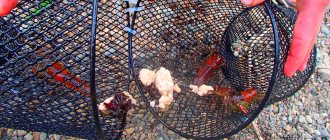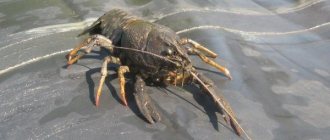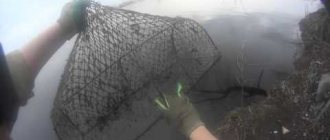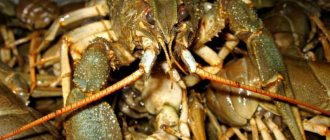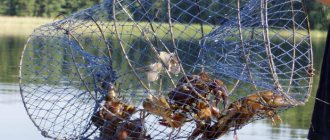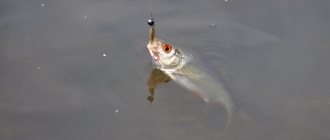People have been catching crayfish since ancient times. And in the Middle Ages they were even used for medicinal purposes: the ashes from these representatives of the order of decapods burned alive helped against the bites of snakes, rabid dogs and scorpions. Aesculapians prescribed boiled crayfish, for example, during treatment for exhaustion.
Back in the sixteenth century, the Swedish royal court praised the taste of crayfish. The peasants caught them and delivered them to the houses of the nobility, but they themselves treated this “shell-shelled beast” with a degree of distrust.
general information
Crayfish are quite whimsical to their living conditions. The body of water in which they can exist must be fresh, since they do not reproduce in a salty environment. In addition, crayfish are sensitive to pollution, but if the living conditions around them are favorable, then they can be found in a variety of places - lakes, oxbow lakes and streams. However, most often they are still found in rivers.
Crayfish are twilight inhabitants of water bodies. Their intensive feeding period occurs after sunset or at dawn, although in cloudy weather they also eat during the day. To search for food, they can crawl ashore, remaining there for several hours. Crayfish feed on aquatic vegetation - shoots of pondweed, water buckwheat, etc. But for normal development, these arthropods also need animal food. Therefore, they eat mollusks, mosquitoes, caddis fly larvae, tadpoles, sick or dead fish, frogs, etc.
What bait should I use to catch crayfish?
The basis of the bait placed in the crayfish trap is: fish meat, animal or poultry meat, frogs, grasshoppers, etc. These are those food objects that are either found in a body of water or fall into it. And here, the opinions of some crayfish lovers differ.
Some argue that products that have a rotten smell are more effective, while others believe that products should be fresh, but not alive. In this case, everything depends on the presence of such food objects in the reservoir. If there is a lot of food, then the crayfish will look for fresher food, and if the crayfish have difficulties in feeding, then they do not particularly pick at food and eat everything.
As bait, crayfish can be offered mollusks that live in a given reservoir.
When to catch crayfish?
The fishing season for these arthropods begins in July and lasts until the end of the second autumn month. Catching crayfish in September depends on the weather and water temperature. From the second half of the month, the amount of production begins to decline.
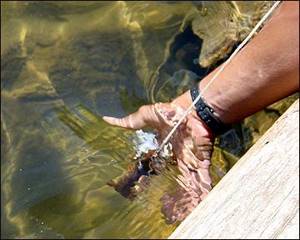
Towards the end of October, crayfish meat changes its taste, and its shell gradually hardens. If it was warm in May and June and the water temperature remained high, then the molting of these arthropods ends before the onset of the hunting season. And then from the beginning of July the catches are good. But if the summer was cold and the molting was late, then the crayfish will begin to move only from the end of July, after the shell has completely hardened.
Features of catching crayfish in October
Crayfish fishing is considered to be most productive in October. It is in the second month of autumn that crayfish begin their breeding season, a characteristic feature of which is their forays onto the shore. Correctly identifying creep points is not difficult.
It is enough to determine the deepest place, and we can assume that the catch will be ensured.
Of course, this is only half the battle; then you should be patient and wait for the crayfish, which crawl out to the very edge of the shore almost right into your hands. This is very simple, however, your dexterity will be relevant here. The secret of such luck is quite simple: the peak of air cooling occurs at night, and the water temperature near the shore becomes as warm as possible, sufficient to warm the crayfish.
Another important fact:
For the convenience of such fishing, it is advisable to go out hunting on an autumn night in two or three and move one after another along the entire coast. The task of the first is to use a flashlight to shine through the water and detect crayfish - they can be easily identified by their red glowing eyes. The second one follows and collects the prey, and the third one puts the catch in a bag and carries it himself.
For greater confidence in the fishing process, you can use a little trick:
It is necessary to cover the arthropod with a net from above, then slightly drown it into the muddy bottom and scoop out all the contents onto the shore. This technique eliminates the possibility of cancer leaving from under the nose.
The recommended length of the net handle is about 2.5 meters, since the location of the crayfish is 1-2 meters from the shore. Another point that you need to pay attention to: if the other individuals are located a little further from this place, you should not reach them. It will not be possible to cover everyone instantly due to the thickness of the water, and sensing danger, the cancer will simply move away.
In the reeds
Many reservoirs have backwaters with reeds. Of course, these points are of little use for people swimming, but they are considered an ideal place for crayfish to live. Of course, catching arthropods here will be very successful, but it will be complicated by the germination of reeds.
During the catching process, it is advisable to swim slowly along the reeds and carefully scan the bottom, since crayfish are perfectly camouflaged, and detecting them is quite problematic.
In quiet creeks with tree roots
Yes, there is plenty to roam around here, but don’t forget about the potential dangers. Since each water area has its own unexplored places, and if it is also muddy water, then you should be extremely careful.
It is recommended not to make sudden movements during the search process and to catch detected crayfish as quickly as possible. Based on the experience of knowledgeable fishermen, in such backwaters with snags there are quite large, albeit old, specimens of arthropods. They are distinguished by the dark brown color of their shell and their slowness in movement, which is very beneficial for the catcher. In rare cases, young crayfish may live here.
On a rocky bottom
The presence of a rocky bottom in a reservoir is an excellent place for natural shelters for crayfish, which hide at the slightest danger. You should not grab the arthropod by the claws extended from these burrows, since there is a chance that you will only get its limbs.
It would be more correct to grab it by the mustache, which always sticks out of the mink.
You need to lift the stone with caution so as not to disturb the water (not to stir it up) and not to scare away the crayfish, which will take advantage of the moment and move to a distant place.
We should not forget about precautions in such an area: you should not reach your hand directly into the arthropod’s burrow itself, as there is a risk of injury (bruise, broken fingers).
In a shell rock
The difference between such reservoirs is the bottom, which is almost completely covered with small parts of reeds and settlements of mollusks, which is favorable for the habitat of crayfish. Such conditions are quite beneficial for camouflaging arthropods, so it is recommended to be careful.
On a sandy bottom
The presence of a sandy bottom greatly simplifies the process of catching crayfish for beginners. It is enough to be extremely careful, and success is guaranteed, since the water is not cloudy due to the fine sand.
In minks and banks
This is a rather dangerous undertaking, since you can stumble upon large holes where muskrats live and seriously injure your hand by sticking it into this house.
You should know that crayfish's homes are small: height 4-5cm, width 7-8cm.
The favorite place for crayfish to live is in bottles and cans.
The advice here is simple:
You should lift the can or bottle with the open side facing you. This way the cancer will not be able to leave and will remain in your hands.
You should always be very careful!
For crayfish in September
The weather greatly affects this type of “hunting”. It is easier to catch these arthropods on a cloudy or rainy day than on a clear day. That's why many people believe that catching crayfish in the fall is the most fruitful. But in windy and very bad weather, in a thunderstorm or rainstorm, it is better not to go to the reservoir, since it is unlikely that you will be able to return home with the spoils.
Crayfish fishing in September occurs at a depth ranging from thirty centimeters to a meter. The burrows of these reservoir inhabitants are not too difficult to find. They can occupy any depression between stones or snags. But only adult individuals can be found there; it is better to look for young animals in shallow water.
Lures for crayfish
Lures for catching crayfish should be selected taking into account the season of the year. Plant options will be much more effective in spring and summer, animals - in autumn and winter.
Their animal baits you can choose from:
- Pieces of fresh fish;
- shellfish;
- meat;
- frogs;
- worms;
- chicken and animal giblets.
Fish can be used fresh or slightly spoiled. To do this, it should be kept in the open sun for some time. More than other fish, bream, roach or crucian carp are to taste.
For meat products, you can use beef or chicken. You can also spoil it a little in the sun. Clams, snails and frogs must be caught in the same body of water where you plan to catch crayfish. But worms should be used for catching arthropods only in exceptional cases when other bait options are unavailable for some reason.
Better than other plant-based bait options for catching crayfish, this
- sprigs of dill;
- pieces of black bread;
- garlic;
- cake or flour (in a briquette);
- corn;
- peas.
Peas and corn for catching crayfish should be boiled or used in canned form. Garlic can be added to any bait - meat, bread, fish.
In addition, baits for catching crayfish can be sprinkled with fish oil, which will also enhance their attractiveness.
Crayfish are freshwater arthropods protected by an armored shell with an abdomen-neck and powerful claws. In male representatives they are large, and the tail is not too wide, unlike females, since with its help females protect eggs - their future offspring. But both male and female can be recognized only after they are taken out of the water. Given the habits and tastes of these hermits, they can be caught at any time.
The mustachioed inhabitants of the underwater world prefer clean water reaches enriched with lime. Favorite habitats are freshwater rivers, lakes, streams and oxbow lakes, where there is no strong current. They do not reproduce in salt and fresh-salt water. If the water in the pond becomes polluted, after some time the owners of the claws and shell disappear from it forever.
Crayfish most often make their homes in the coastal zone, inhabiting places near large banks with cliffs (where it is easiest for them to dig holes). Being hermits by way of life, they hide in such shelters from relatives and hunters. Each cancer has its own personal refuge and practically does not change its place of residence. You need to remember this when going on a search.
Crayfish can be lured out at any time of the year, with the exception of January and February - in deep winter they prefer to hole up in their burrows. The arrival of spring is not very conducive to successful catching of these representatives of the aquatic world - they are just waking up from hibernation. But sometimes pleasant exceptions happen.
May-June is a special period for those with claws - they molt, shedding their old shell and taking care of procreation. During this period, a strict fishing ban is introduced, as they become completely defenseless.
From July (in different regions and reservoirs these dates may be pushed in one direction or another, because conditions in the Kuban and Ladoga are noticeably different), arthropods begin an active search for food, quickly migrating along the bottom. At night and early in the morning, they annoy fishermen by eating baits on hooks. In September, crayfish rush to leave their burrows in search of food, but they gain special taste qualities in late autumn, so it is at this time that their catch is considered the most productive.
Catching crayfish in October is not too difficult and very exciting. If you know the places and features of successful catches, you can always count on luck. In autumn, arthropods begin their breeding season, which requires abundant nutrition and frequent forays into shallow water in search of food. The ability to choose the right tackle will help you catch rich catches.
There are many ways to catch crayfish:
- hand fishing;
- fishing with a float or special fishing rod;
- use of clamshells and other devices.
Catching by hand is considered the most primitive of all methods, but in October-December this method of catching is not only uncomfortable, but also harmful to health due to the low water temperature.
Autumn fishing tricks
Many experienced crayfish fishermen go to the reservoir in the late afternoon to go out hunting for prey after dark. The easiest way to catch crayfish in the fall is with a flashlight. This is the simplest and most unpretentious method, in which the only gear is a “beam of light.” Actually, the hunt itself takes place as follows: one of the fishermen illuminates the bottom of the reservoir with a powerful spotlight, and the other walks nearby and uses a net to collect prey in a cage. This fall crayfish fishing is very similar to picking mushrooms after rain. Often, the prey crawls ashore on its own, where it can be easily collected without any effort.
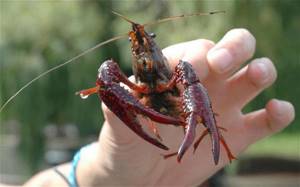
However, such unpretentious at first glance, catching crayfish in the fall has its limitations: the water in the reservoir should be as clear as possible. Only in this case will the flashlight be able to illuminate a sufficiently large area. This “collection” of prey occurs at a distance of two to three meters from the shore.
Fishing technique
It can be very difficult to freely approach a place on a reservoir where crayfish are found due to the fact that their shoreline is overgrown with reeds. Experienced fishermen advise placing crayfish traps from boats.
In order not to spend a long time looking for traps along the entire bottom of the reservoir, but to be able to easily find and lift them, a homemade foam float is tied to the top of the cord. It will indicate the location of the trap.
You can also set the trap from the shore, following a certain sequence:
- find a stick with a slingshot at its end;
- take the cord from the trap in one hand and the stick in the other;
- lift the trap by picking up its cord;
- slowly lower it into the water;
- Tie the cord from the trap to a tree or stick.
It is recommended to install crayfish traps at a distance of 10-30 m from each other and at different depths. The best time to check is once every 3 hours. Lifting it out of the water by the cord, the catch is taken out, and the empty shell is lowered back into the water.
By applying all these tips, you can be sure that fishing for crayfish will bring only positive emotions and a sense of satisfaction.
The easiest autumn fishing method
The only equipment required is a fairly powerful spotlight to illuminate the bottom, a net to pull arthropods out of the water, and, of course, a bag or cage in which to put the prey.
This kind of crayfish fishing in the fall is most effective if two or three people participate in it. At the same time, certain requirements are imposed on such equipment for catching crayfish as a net. Its length must be at least two meters. You need to take as light a stick as possible as a basis. The latter characteristic is required in order to be able to capture the crayfish along with the surrounding silt or part of the clay bottom, reducing the likelihood of its escape.
Where to fish?
Crayfish, as is known, are found only in clean water bodies. If a lake or river is heavily polluted or not rich in oxygen, then going there for these arthropods is a waste of time. At the same time, the best places for catching crayfish are those in which the water stagnates faster.

These underwater inhabitants are found at different depths: in some lakes and rivers you can catch crayfish by going into the water up to your knees or a little higher, while in others you have to look for them at a depth of up to three meters.
These arthropods are big fans of rocky bottoms, where they find numerous hiding places. They can often be found in reservoirs with clay soil. Here they dig burrows under the shady steep banks. But in shallow places where there is a hard sandy bottom, it is impossible to find them. These underwater inhabitants cannot tolerate reservoirs with muddy or densely overgrown algae bases.
Methods of catching crayfish
These arthropods can be caught in a variety of ways. This can be either catching crayfish by hand, or using special inventions for this type of hunting. Many fishermen do not understand, and therefore ignore, catching these arthropods, believing that there is no excitement or sporting interest in it. However, those who have at least once felt the pleasure of catching them will never miss the opportunity to get pleasure again.
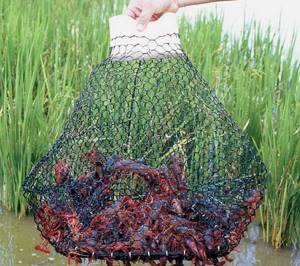
The most common methods of catching crayfish are:
- hands;
- crayfish traps;
- fishing rod;
- by borders.
All of them are catchable and are not considered poaching.
Catch without equipment
Catching crayfish with your hands is the most primitive and ancient method. The catcher, moving carefully in the water, looks under stones or tree trunks, under which these arthropods hide during the daytime. Having noticed the prey, he quickly grabs it so that it does not hide or run away. Of course, this method of catching crayfish is not suitable for those who are afraid of sharp claws. The largest “harvest” can be gained at night, when crayfish emerging from their shelters are easily collected by illuminating the bottom of the reservoir with a lantern.
You can grab them with your hands only when the depth of the river or lake is no more than one and a half meters. For deeper places, so-called “pincers” are used. This wooden device for catching crayfish makes it easy to catch and lift prey from the water. The pincers are from one to three meters long, and so that they do not damage the catch, they are made hollow.
A simpler equipment is considered to be a long stick, at the end of which there is a split, expanded with the help of a small pebble or wooden block. With such a device it is impossible to pull the crayfish out of the water; it is only used to press it to the bottom and only then remove it with your hand. Fishing with ticks requires quite a bit of skill, since these arthropods only seem to be slow. But as soon as they sense danger, they run away very quickly.
Proven recipes for bait for catching crayfish
The best homemade bait for catching crayfish is different for each fisherman. But there are universal, time-tested recipes.
Garlic
Ingredients:
- Rye bread;
- garlic.
Garlic is grated or cut in half and crushed. With the second option the aroma will be stronger. The bread is cut into pieces and lightly fried in oil. It is permissible to use the product without frying. Garlic is crushed inside the bread and rubbed onto the crust. You can make garlic balls. To prepare them, I pass the garlic together with the loaf through a meat grinder, and the resulting mass is rolled into small balls. To prevent them from becoming soggy in water, they are placed in nylon or gauze bags.
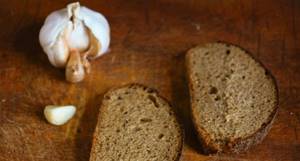
Photo 2. Bread with garlic - delicious!
From the top
Ingredients:
- cake;
- bread;
- dill.
The compressed sunflower seeds are cut into medium pieces. Rye bread and dill are added to them. It is advisable that the dill be fresh. But you can also use dried. Mix everything thoroughly and place in gauze.
Fish
Before preparing the bait, fish are caught from the reservoir where the crayfish live. Fresh frozen from the store will also work. An incision is made along the ridge. The air bubble from the carcass is squeezed out or punctured. The scales need to be picked, but it is better to remove them from the crucian carp. Large fish are cut into pieces, and small fish are used whole.
Hepatic
Ingredients:
- beef liver;
- flavoring (shrimp) or fish oil;
- chicken entrails.
The liver is left in a warm place for 1-2 days to allow it to spoil. Then it is cut into small pieces and covered with flavoring or sprinkled with a small amount of fish oil. Add some chicken entrails or skins. The bait is wrapped in gauze.
Frog
Crayfish love missing and dried carcasses. The dead frog is cut into two or four parts and the skin is removed. You can pick up dried remains of amphibian bodies near a reservoir.
Pea
Canned peas are mixed with dill and poured into cheesecloth. You can add corn, corn, grasshoppers, canned food, and leftover homemade food to it.
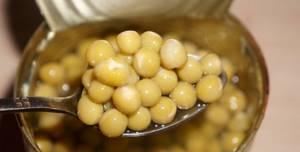
Photo 3. Pea crayfish bait.
Angling

Cancer grabs onto her and holds on tightly. And the hunter just has to catch it with a net and pull it out of the water. Catching crayfish with a fishing rod differs from fishing for fish in that it does not use hooks, so the prey can come unhooked at any time. In this case, the gear is made primitively and simply: a fishing line is tied to a two-meter stick, and bait is tied to it. The end of the fishing rod is secured: this can be done by sticking it into the bottom of a lake or river near the shore. The catcher can use several gears at the same time.
The baits attract crayfish in standing water over an area of about ten square meters. Therefore, you should not place fishing rods frequently. It is better to stick the gear on the coastline at a distance of five or seven meters from each other.
All evening and at night, depending on the intensity of the zhora, the fishing rods need to be checked periodically, sometimes even four times in an hour. The catching area should not exceed two hundred meters in length, so that it is convenient for the hunter to check the fishing rods in time, so that the crayfish do not have time to eat the bait and leave. If during one evening the catch goes down, then it is better to move to a new place.

When checking the fishing rod, you need to carefully pull it out, slowly and smoothly lift it so that the crustacean that has grabbed onto the bait does not unhook, but is pulled together with it to the surface. Then the fisherman carefully picks up the prey with a net lowered into the water from below.
What gear can be used
The following are considered catching devices:
Catching catfish in September
- Rakolovka is a tool assembled from metal wire and mesh.
- Merezhi. It works on the same principle as a clamshell, but is more reliable.
- Draghi. A rectangular device made of rods with a bag and cord.
- Rachevnya. It looks like a basket made of intertwined twigs.
- Prison. It is a long stick with splits at the end.
- Fishing rod. Fishing gear with a bag of bait attached to the line.
- Nonsense. The device is similar to a crayfish catcher, but there is a separate bag where the crayfish end up.
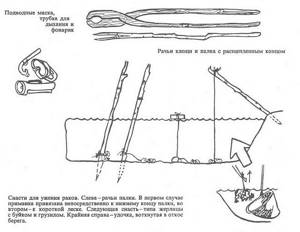
The photo clearly shows the most popular and effective fishing methods.
There is another fishing tool, but we do not recommend using it - nets. Their installation is prohibited by law in many countries. Because they cause irreparable harm to the reservoir and the inhabitants living in it. This kind of fishing is poaching.
Secrets of night fishing
It is considered the most effective. With the arrival of autumn, the nights become colder, and frosts are possible in some places. And it's still warm during the day. The water no longer has time to warm up properly, only shallow water. Therefore, in the dark, crayfish crawl out of their holes to the coastal zone to warm up and profit.
Night fishing brings catches from September until the first ice forms on the reservoir. You need to wait for individuals in deep places.
You need to go searching with a bright flashlight or an artificial torch and a landing net. It will be difficult to cope alone, so it is better to take someone else to help.

With the light of a flashlight, crayfish can be detected by the red color of their eyes, which sparkle.
The team moves in a chain (one after another). The first person shines a light on the water and looks for arthropods. The second catches the prey with a landing net or simply with his hands. The third puts it in a safe bag or container so that the catch does not escape.
When choosing a landing net for night fishing, you need to give preference to a powerful pole that will not bend or break in the water.
The optimal length of the handle is 2.5 m. This will be enough, because crayfish are 1–2 m from the shore at night.
The discovered individual is covered with a net from above, slightly drowning it in the silt, after which it is pulled ashore. In this method, the likelihood of losing the catch is minimal.
Catching with a fishing rod
Modified mining method. In this case, the crayfish grabs with its claws the bait, which is tied to the end of the fishing line or the stick itself, and holds on to it. The main thing is to react in time and carefully pull the trophy ashore.
It differs from regular fishing in that there is no hook at the end of the fishing rod, which is why the catch can come off at any time.
It is allowed to use up to 10 fishing rods at the same time. It all depends on the presence of individuals in the reservoir, the activity of the zhor and the number of your baits.
The action diagram is as follows:
- A fishing line is attached to a stick 1–2 m long.
- The bait is securely attached to the fishing line, which is best wrapped in gauze so that it does not wake up or get lost ahead of time.
- The end of the stick is stuck into the bottom of the reservoir not far from the shore.
- The bait should lie freely on the bottom.
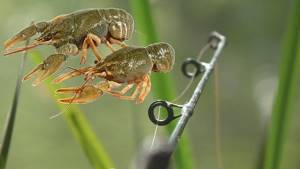
You need to install fishing rods at a distance of approximately 2.5 m from the shore, the distance between them is at least 5 m.
It is advisable to check the tackle at least 3 times an hour. The fished area of the reservoir should not exceed 200 m in length. Up to 12 crayfish can be pulled out in one cast of fishing rods.
If the line begins to sway, this is a signal that the crayfish has taken the bait. The end of the stick is pulled out from the bottom, and the tackle is carefully pulled to the shore, where the landing net catches the prey.
Alternative options are to use a zakidushka, a zherlitsa, or a so-called crayfish stick. The fishing technique is similar. The only difference is that a float is also attached to the bait, a sinker is attached to the bait, and a piece of fishing line is either short or absent in the crayfish stick, so the bait is attached to the other end of the stick.
We use crayfish traps
If hand fishing with a flashlight is considered prohibited in many regions, is it possible to use crayfish traps? Of course yes. The only thing is that there are certain restrictions on their number. Depending on the requirements of different fisheries, 3–10 pieces can be used at a time.
The shell is a frame assembled from durable metal wire, mesh and cord. The upper part of the device is specially made narrow so that, once inside, the cancer cannot crawl back out.
At the bottom of the crayfish trap, attach the bait and lower the device to the bottom. The cancer crawls in to try the treat and can no longer get out. Using this method, you can pull out more than a dozen individuals at a time.
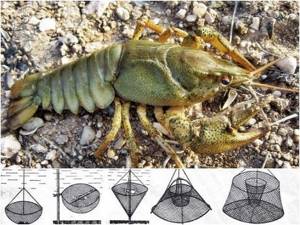
Among the various forms of devices, the conical folding one is considered the most catchy. You can try to assemble it yourself or purchase it in a store.
Advantages of use:
- affordable price;
- ease of installation and removal;
- does not need frequent checking;
- convenient for transportation;
- The bait is easily attached inside the device.
As for installation sites, the coastline is not the best option, since it is often overgrown with reeds.
The easiest way to lower clam shells into the water from a boat is to attach a foam signaling device to the cord.
By design, the device is divided into two types.
Open
Easy to manufacture and assemble. They are easy to make with your own hands.
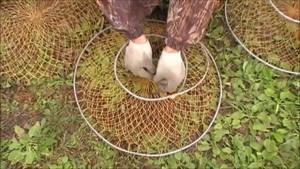
The photo shows an example of such a device
The materials most often used are wood and metal mesh. The frame is designed in a round or square shape. It looks like a colander.
The design is based on a circle, a square (made of metal, wood) with a diameter of 50 to 70 cm. A metal mesh is mounted to it on one side, and a rope or cord on the other, thanks to which the crayfish is immersed and taken out of the water.
Closed
Not as easy to assemble as the first type, but much more effective. Its design eliminates the possibility of the cancer getting back out. Folding devices are considered convenient to use and transport.
Correct installation of bait
Performed in one of three ways to choose from:
- Using an elastic band to the body of the shell.
- On a pin or piece of wire.
- Sew a pocket of nylon thread to the bottom of the device, where to place the bait.
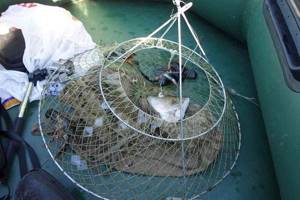
If the bait is a fish, then so that it does not start to float, a bubble is squeezed out.
Reliable fastening of the bait is needed so that it reaches the bottom of the reservoir together with the crayfish, and the cancer does not get out with it, but begins to try the delicacy while in the trap.
Traps
Today, crayfish are widely used to catch crayfish - cylindrical nets stretched over a round metal hoop. The latter is most often made of galvanized wire. Its most common diameter is fifty centimeters. To avoid skewing the hoop, three or four thin cords of equal length should be tied to the hoop at the same distance. They are connected by one common knot, into the loop of which a stronger rope is threaded for raising and lowering the gear. When fishing from the shore, the end of the cord is attached to a pole.
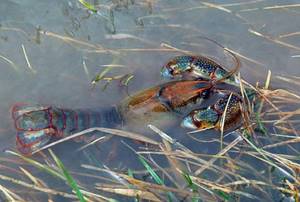
The bait is tied to the net on a cord stretched across the diameter of the hoop. The trap then sinks to the bottom. The cord for lifting the crayfish is tied to a buoy or pole fixed to the bank slope. This type of fishing is based on the following: prey that clings to the bait no longer has a chance to get out. You need to lift the crayfish quickly, without hesitating.
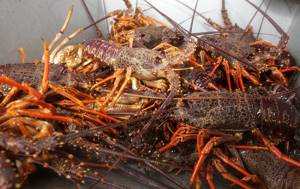
You can hunt with several ranches at once. Typically, traps are placed at a depth of one to three meters.
How to catch crayfish using a crayfish trap?
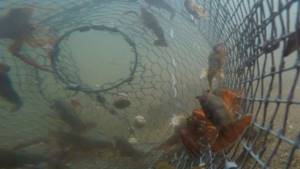
Rakolovki are divided into two main types:
- Open type shells. These are the simplest equipment to design and manufacture for catching crayfish. Any fisherman can make such a crayfish catch if he has the desire and a little free time. It consists of a round or square frame with a metal mesh attached to it. The diameter of the crayfish can be in the range of 50-70 cm. In appearance, this tackle resembles a colander. A reliable rope is attached to the structure from above, which serves to lower and raise the shell.
- Closed shells. Such traps are more effective than previous designs, but more difficult to manufacture. Despite this, they can be designed to fold. In this case, it will be convenient to transport it.
Lure attachment
The bait, which serves as an object for attracting crayfish, is attached to the bottom of the trap in any available way:
- A special pocket made of gauze or nylon is attached to the bottom of the shell. Subsequently, bait is placed in it.
- The bait can be secured with an elastic band.
- It is possible to use other fastening options, for example, using wire.
Lures
Crayfish eat almost anything: worms, corn, but are especially well caught on rotten meat or fish. This means that it is advisable to use the same rotten meat for luring. Canned peas also attract crayfish well.
Those who are going to fish with traps can simply pour a can of these legumes into cheesecloth, tie it up and attach it to the crayfish trap. If there are arthropods in the reservoir, they will definitely smell the bait.
Experienced crayfish fishermen advise using makukha or black bread for this purpose. It’s interesting, but in different bodies of water, crayfish react differently to identical bait.
Bait and crayfish fishing seasons
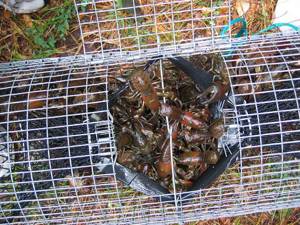
Bait for crayfish in spring
In the spring, cancer may prefer fish meat, or rather fillet, as well as small fish, cut so that it emits the desired smell. Ordinary crucian carp, gobies or other small fish will be used as bait. You can either catch the bait yourself or purchase it frozen. Before use, it is advisable to dry the fish to such a state, after which a peculiar smell will appear.
Lure for crayfish in summer
In the summer, when there is enough food for crayfish, it is very difficult to interest them in anything. Therefore, in the summer, it is better to use animal or poultry meat as bait, as well as offal or parts of animals, such as ears, liver, stomach, etc. All these little things can be bought separately on the market. Like fish, it is better to keep animal parts in the sun for a while.
Bait for crayfish in autumn and winter
With the onset of autumn, and even more so winter, the level of food supplies decreases sharply, which leads to a certain lack of food for everyone living in the reservoir, including crayfish. Moreover, with the arrival of autumn, crayfish try to eat more in order to stock up on fat. Therefore, during this period, crayfish can be interested in ordinary bread with garlic, wrapped in gauze. If this is not done, the bread will very quickly become soggy and cease to serve as bait. In addition, during this period you can attract crayfish with non-fresh fish or meat.

